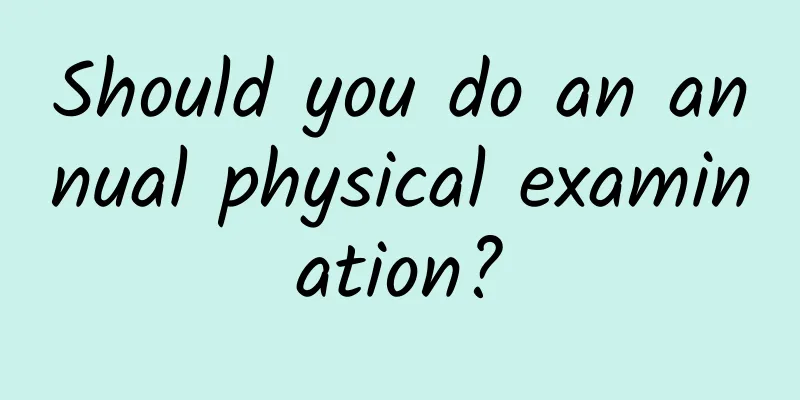Should you do an annual physical examination?

|
Regular physical examinations can help detect and treat diseases at an early stage, and their importance is beyond doubt. However, it seems paradoxical that some people have normal physical examinations every year, but when a problem is found, it is a serious illness. In recruitment advertisements, some units list annual physical examinations alongside insurance and salary, making it seem like a benefit provided by the employer. Some experts suggest that from the perspective of the probability of incidence and prevalence, young people do not need to have annual check-ups, but older people should do it every year because they are more likely to get sick. In fact, the frequency of physical examinations has nothing to do with age. The drawbacks of over-screening and over-treatment are the same. First, it increases expenses and wastes medical resources. Second, invasive examinations have hidden dangers that affect health. For example, even the most common blood tests have risks in the future. The inner wall of the blood vessels is originally smooth. In order to draw blood for testing, the needle pierces the inner wall of the blood vessels, and the body's protective mechanism is activated. Platelets aggregate at the bleeding site to form tiny blood clots to achieve the purpose of hemostasis. There are many similar operations. Although you may not get myocardial infarction in the future, it increases the probability of getting sick. Third, it increases the psychological burden. Some of the problems found are symbiotic with the human body. The body has a self-regulating mechanism. Excessive intervention will break the self-healing balance and be detrimental to health. Physical examination is of great significance to disease prevention and treatment and health maintenance, and it should be done. Not only should the efforts not be weakened, but they should be strengthened. They should be done every day to understand one's own situation in real time and to discover potential problems earlier than the hospital physical examination results. However, it is not always done in hospitals, as hospitals cannot do it. This is why some people have normal physical examinations every year, but when a problem is found, it is a serious illness. The three-foot-thick ice does not form overnight. There are always clues before the disease occurs, but you just don’t notice and are not sensitive. How can we avoid over-screening and missed diagnoses at the same time? You can do a self-examination every day for free and keep track of your own condition in real time. Health is manifested by not being aware of the existence of the body. When you feel the existence of a part or the whole body and detect abnormal conditions, go to the hospital for a targeted physical examination to prevent problems before they occur. Sit quietly and observe your inner thoughts often, and feel the dialogue with your body. Be relaxed, calm and natural. Relaxation means relaxing the whole body, including the body, mind and spirit. Calm means quietness of mind. Natural means that posture, intention and breathing should be natural. The nature of receiving qi is natural and will not be changed by external things. One thought replaces all thoughts, and the clear and bright qi is like a god. Free and unrestrained, like a cicada shedding its skin from the dust. This kind of sitting posture for meditation has existed since ancient times, which conforms to the natural law of biology. Moreover, this posture, in general, is very similar to the posture of a fetus in the mother's womb, peaceful and tranquil. Meditation is a method of self-cultivation that is beneficial to the body and mind. During the process of meditation, people's mental thoughts are relatively quiet, and the thoughts in the mind are relatively reduced, so the blood circulation is also relatively slow, and the heart is also relieved of the burden. At the same time, because the body posture is placed correctly, no more exercise to consume physical energy, the endocrine of the pituitary gland is evenly distributed, and gradually feel the limbs and internal organs, and a feeling of fullness occurs. After this feeling occurs, the most sensitive parts are the central nervous system and the end of the spine, together with the kidneys, which usually feel tight and irritated. From here, it gradually progresses, following the flow of qi and blood vessels, and the feeling occurs in each part, as if something is moving. If your body is not straight, your breathing is not continuous, and your mind is not calm, you will definitely get sick! Do not confuse meditation with immortal cultivation or Zen Buddhism. The method of sitting cross-legged in meditation is originally a posture of ancient Indian yoga. Its benefits to the body and mind have scientific basis and are not interpreted with any religious color. It is not the content of Buddhism, nor is it the content of Taoist cultivation of immortal inner alchemy. It is just a posture and method that can be used for all cultivation of body, mind, nature and life. Meditation can help you detect potential diseases in your body at an early stage. After the energy in your body is generated, it will flow to a place where there is a disease, and if there is no disease, it will pass through quickly. The feeling of physical discomfort during meditation is because there is already a root of disease inside. When you meditate, the Qi and meridians cannot pass through, so there are blockages, pain, numbness, and swelling. This can help you detect physical diseases early, and before the disease occurs, during the incubation period of the disease, rather than causing these diseases because of meditation. If you insist on meditation, you can release it in stages and batches in advance, so that it will not accumulate from small diseases to big diseases, and suddenly break out one day, or even become uncontrollable; it can promote the self-healing effect of the internal body. If you persist, early prevention, early detection, and early treatment will definitely restore your true health. Extreme stillness will inevitably lead to movement. Latent diseases inside the body will quickly break out under a state of stillness, and will be triggered by meditation. This is not a bad thing, nor is it a problem caused by meditation. It is not that a good thing has turned bad, but that the problem was already there, and this life force must manifest through the blockage. If there is vibration or throbbing in the meridians and acupoints, it is mostly due to obstruction. Pain in a certain part of the body is mostly a reflection of the lesion, and the internal Qi is colliding with the lesion. This reaction usually lasts a long time and is repeated many times. It is the process of the lesion beginning to heal, and you need to be fully prepared. Do not condone it, but do not force it. Relax, do not be nervous, and do not force it. A simple and easy self-examination takes only a few minutes. It allows you to observe and examine your body through your own senses or with the help of simple auxiliary tools. Self-screening for existing or potential health problems or reactions to life processes can help to screen out many diseases. Simple self-examination. (1) Take your temperature to see if it is high (2) Feel the pulse to see if it is fast or not (3) Feel your breathing and see if it is even or uneven (4) Measure blood pressure to see if it is high (5) Check the color of the skin and mucous membranes to see if there is pallor, cyanosis, yellowing, edema, bleeding, rash, etc. (6) Check for swollen lymph nodes under the jaw, behind the ears, neck, armpits, thighs, and behind the knees (7) Check whether the white of the eye is yellow (8) Check whether the tip of the tongue is tilted when it is extended (9) Open your mouth wide and make an "ah" sound to see if the tonsils on both sides of the "uvula" in your throat are congested or swollen. (10) Do you feel you have any special oral odor? (11) Is your neck stiff? (12) Gently press the abdomen to check for tenderness, rebound pain, or masses (13) Hold your fists with both hands and tap the small of your back with the knuckles of your fists to see if there is any pain. (14) Does your stomach often make growling sounds when you are not hungry? (15) Is there blood in the stool? (16) Is there any restriction on the front, back, left and right convex movements of the body? (17) Whether there is edema in the face, hands, and feet (18) Any abnormality in eating? (19) Any abnormalities in urination or defecation? (20) Any abnormalities in sleeping? If you answered "yes" to any of the above questions, go to the hospital for a check-up first to rule out the disease and cure or control its development. The most basic diagnostic methods in modern medicine are inspection, palpation, percussion and auscultation. The most basic diagnostic methods in traditional medicine are inspection, auscultation, questioning and palpation. The commonality is that inspection ranks first, which shows its importance. Each part of the human body does not exist independently, but is interconnected and mutually restricted. From the internal organs, limbs and bones to the five sense organs, nine orifices, skin and hair, everything is closely connected. If a part of the body is diseased or uncomfortable, other parts, or even the whole body, will be disturbed or affected. Each part of the body is a portable medical examination report. The prosperity, decline and pathological changes of the five internal organs will be manifested on the surface of the body through the media such as blood and body fluids. When the organs and tissues in the body are diseased, the specific parts will produce corresponding changes and reactions. If there is something wrong with the five internal organs, each part will know it earlier than you, such as eyebrow diagnosis, eye diagnosis, nose diagnosis, ear diagnosis, lip diagnosis, tooth diagnosis, tongue diagnosis, face diagnosis, hair diagnosis, spine diagnosis, back diagnosis, navel diagnosis, buttocks diagnosis, hand diagnosis, pulse diagnosis, leg diagnosis, foot diagnosis, in addition to the two bowel diagnosis. Simply by observing the shape and color of various parts, you can understand the body's physiological functions and pathological changes, judge many symptoms, discover potential problems in the body early, and intervene and regulate in advance before the hospital physical examination results. This is an important, simple and effective method to diagnose, identify and understand diseases. |
>>: Are “sugar-free” foods really sugar-free?
Recommend
What to do if the cervix is loose
If you find that your cervix is loose during a ...
What is the treatment for vulvar white spots?
The impact of vulvar leukoplakia on female friend...
What to do if non-invasive DNA is high risk
Many people may not be so clear about the high-ri...
Mastectomy
Abnormal sensations in the breast require treatme...
What to drink to quench thirst during confinement
In many areas, it is traditional that women are n...
Where should cupping be performed for gynecological diseases?
In life, every woman will inevitably have some gy...
There are blood clots in menstruation
When women have their period, their private parts...
How to reduce fever during confinement?
During the confinement period, the mother's b...
People are on the ring at the same time
There are many things you need to pay attention t...
How to treat uterine prolapse
We all know that the female uterus is a place whe...
Can I get pregnant if I have bleeding during ovulation?
It is said that the chance of pregnancy is higher...
Why do we pay so much attention to "rare diseases"? Treatment technologies for more than 7,000 rare diseases accelerate innovation in life sciences
Introduction According to statistics, there are m...
What to do if your eyes hurt after childbirth
Some female friends may have nothing to do during...
Can I wash my hair during confinement in summer?
Confinement is a critical period for women. If no...
How to do push-ups for women
We all know that push-ups are a convenient and ef...
![[Medical Q&A] Are obese patients at higher risk for anesthesia?](/upload/images/67f0fe2c2bf86.webp)








